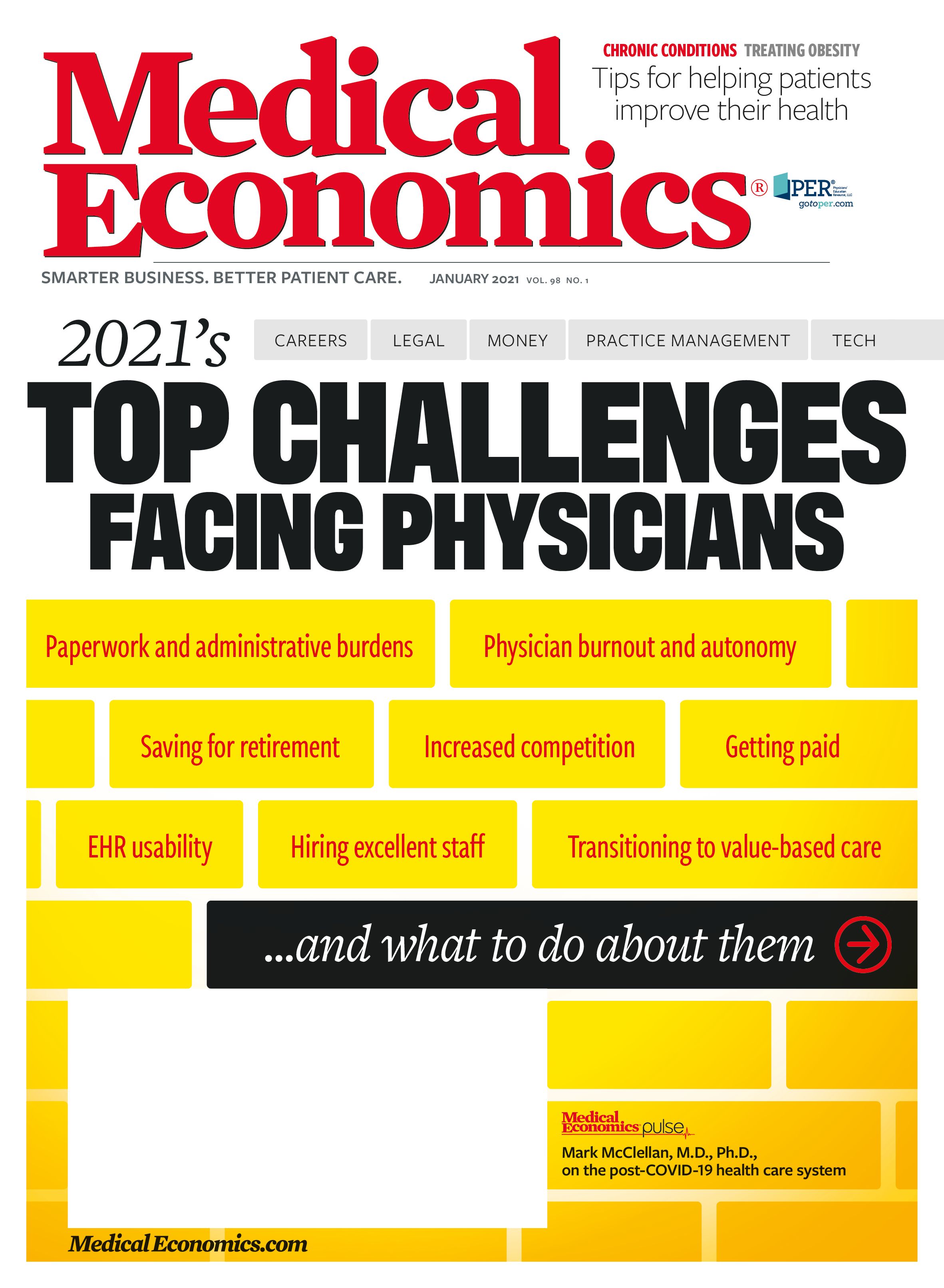Publication
Article
Medical Economics Journal
Tackling obesity
Author(s):
How physicians are addressing obesity as a chronic condition and helping patients lose weight.
The latest CDC National Health and Nutrition Examination Survey revealed that 39.6% of adults and 18.5% of children aged 2 to 19 in the U.S. have obesity.
Obesity can impact essentially every organ in the body. It increases the risk for cardiovascular disease, fatty liver disease and cirrhosis, cancer and, of course, diabetes. Type 2 diabetes rates have climbed along with obesity and diabetes represents an urgent public health crisis.
“There is a plethora of medical conditions that arise from unhealthy weight gain and they are categorized by metabolic changes and physical forces,” says Krishna Doniparthi, M.D., director and physician at Functional Medicine of Georgia in Milton, Georgia. “Metabolic changes entail elevated blood glucose, elevated blood pressure, dyslipidemia, cancer and other metabolic diseases.”
Obesity is a chronic condition that requires a strong physician-patient relationship, honest and direct conversation and personalized treatment plans to tackle.
In 2013, obesity was recognized as a disease by the American Medical Association. Since then, the medical world is beginning to view obesity less as a lifestyle choice and more as a multifactorial dysregulation of hunger and satiety hormones.
Lydia C. Alexander, M.D., an internist in San Francisco who has specialized in weight management and obesity treatment, says adipose tissue is not just an inert storage depot for excess energy but is metabolically active.
“When adiposopathy occurs — also known as ‘sick fat’ disease — inflammation in the body predisposes to other diseases such as metabolic syndrome, hypertension and Type 2 diabetes,” she says. “Given what we know about adiposopathy or obesity as a disease, it is not surprising that obesity is recognized as conferring excess risk for severe sickness from COVID-19.”
In fact, on July 17, the CDC added BMI under 30 kg/m2 as a risk factor for severe COVID-19. Untreated obesity predisposes to increased morbidity and mortality from COVID-19, just as it does for many other health conditions.
Alexander notes the best way to address obesity is through a multidisciplinary treatment approach based on the four pillars of obesity treatment: behavioral modification, nutrition, physical activity and pharmacotherapy, with bariatric surgery as an important adjunct modality for a subset of patients.
“Beyond structuring treatment on these foundational elements, taking a ‘partnership’ approach with patients is key,” she says. “This involves asking open-ended questions, listening, summarizing health goals, collaborating on the treatment and informing the treatment with one’s medical expertise.”
Navigating sensitive conversations
“Would you like to talk about your weight?”
This is considered the first step outlined by the Obesity Medicine Association when approaching a patient about the subject of obesity.
“The language should not be offensive or blaming/shaming,” Doniparthi says.
Sarah Hallberg, D.O., M.S., medical director of the medically supervised weight loss department at Indiana University Health Arnett, notes the most important things to have with you when approaching a patient about the issue of obesity are compassion, evidence and no judgment.
“Being nonjudgmental may seem easy to many physicians, but I ask them to really have a good look in the mirror when it comes to passing judgment,” she says. “It is very easy for us to think that we are acting nonjudgmental, but if it is really an act instead of something that you truly believe, it is easy for patients to see right through that.”
For that reason, Hallberg says evidence is important to bring to a conversation. It is also important for the physician to review the evidence themselves when questioning if they are truly nonjudgmental when facing a patient struggling with obesity.
“Obesity is a disease, not a choice or lack of willpower,” Hallberg says. “Evidence in a patient conversation needs to be centered on the impact that obesity has on morbidity and mortality.”
After speaking to a patient about evidence that supports acting on the disease of obesity, the next thing to discuss is food.
“I can’t tell you how many patient discussions I have been in on and how many lectures on obesity I have listened to where food is not brought up. This is so frustrating,” Hallberg says. “You have to know what your patient is eating to understand how best to help them.”
Alexander notes that unlike many chronic conditions or diseases, obesity cannot be hidden from others. Patients often come into their physician’s office embarrassed and self-conscious about their weight.
“First and foremost, it is important to begin any conversation about weight by asking permission,” she says. “An example of what this looks like may be, ‘Would it be OK to discuss your weight today during our visit?’ Most patients will welcome the opportunity to talk about their weight concerns with the doctor.”
When discussing weight, Alexander suggests using patient-first language, which makes a distinction between the disease and the individual.
“For example, we would not refer to a patient with stomach carcinoma as cancerous,” she says. “We discuss them in the context of having cancer, a disease. They are not the disease. Similarly, it is important to address obesity and a patient as having obesity rather than being obese. Lastly, I think it is helpful to discuss the science behind obesity.”
Too often, patients feel their inability to successfully address obesity on their own is a personal failing and demonstrates a lack of willpower or character flaw, when this simply is not true.
Tips to offer
Physicians who have been able to help patients with obesity often rely on solid motivational interviewing and developing personalized treatment plans.
For most patients, the key to losing weight is to assess their total carbohydrate consumption. As weight has increased in this country over the last few decades, calorie consumption has increased as well. However, the increased calories have all been in the form of carbohydrates.
“The push to get patients to eat a low-fat diet has had unintended consequences as it has resulted in many low-fat, but highly processed high-carbohydrate/sugar products coming to the marketplace,” Hallberg says. “This can be seen in everything from low-fat yogurt to low-fat crackers. For most people suffering from obesity, it is the carbohydrates that need to be cut and not the fat. In fact, fat is incredibly satiating which can be a big help when trying to lose weight.”
Alexander uses a six-point model of “ask, listen, affirm, summarize, inform and treat” when approaching patients about this sensitive topic.
“I think the most important tenets for motivational interviewing include asking permission, patient-first language and taking a collaborative approach to arrive at a treatment plan to improve obesity and the concomitant chronic conditions associated with it such as sleep apnea, diabetes, high blood pressure, GERD, depression and more,” she says. “As part of motivational interviewing, it is important to address internalized weight bias and educate patients on appetite regulation.”
She starts with an open-ended question such as “Tell me more about what’s been going on for you weightwise?” and listens to their response so she understands the root problems.
A patient may mention: “I’ve gained 25 pounds since COVID began in March because the gym closed and I’m more sedentary working from home. I barely get out of my chair. I’ve also been under a lot of stress taking extra precautions to protect my husband’s mom who is living with us from getting COVID.”
That’s when Alexander goes into affirm mode, responding with something like, “It sounds like you have a lot of stressors right now and feel time-constrained to care for yourself in the way you would like,” moving to summarize the problem to make the patient understand she’s been listening.
Next, she informs the patient of what she knows, stressing that a lot has recently been learned about obesity and how to treat it and asking if they would be interested in hearing about the newest and best understanding of why some will struggle with their weight, how effective treatment now exists and how it works.
“An example of a personalized treatment plan would take into account patient preferences and reality,” Alexander says. She suggests “incorporating NEAT — nonexercise activity time— into daily routine on days when formal exercise isn’t possible, managing work and/or school expectations, meditation to manage stress and anti-obesity medication to modulate appetite signaling.”
Good advice
When physicians see that their patients are not losing weight, it might not be that they are not listening, but that perhaps the advice they were given was wrong.
“Health care providers have consistently been telling patients that the key to weight loss and improvement for almost every other health condition is a low-fat diet. What we know now through increased research and research review is that there is no evidence to support this advice as a broad recommendation,” Hallberg says. “In many cases, this approach has worsened medical conditions and certainly frustrated people attempting to lose weight.”
Some reliable evidence-based sources that she recommends to patients are the Obesity Medicine Association, Obesity Action Coalition and Virta Health.
For those who are unsure how to begin changing their nutrition, Doniparthi recommends starting by eliminating easily digestible foods such as sweetened sodas, which tend to be a source of sugars for many people.
Furthermore, he notes to respect the patient’s wishes and don’t force change on them; try to guide them toward the decision to make a healthier lifestyle change.
“Sometimes patients are not ready to make a change,” he says. “Consider using the stages of behavior change to determine where a patient lies: precontemplation, contemplation, preparation, action and maintenance.”
Additional material and resources are available from the Obesity Medicine Association, including a free copy of the Obesity Algorithm, a quick reference guide to understanding the four aspects of obesity medicine: behavior, nutrition, pharmacology and physical activity.





